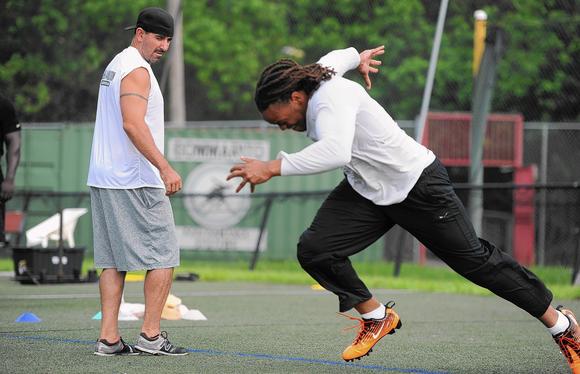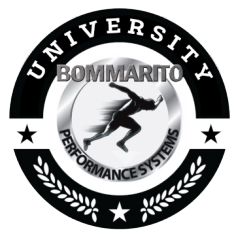- Coach the INTENTION of exercise when training clients/teams/athletes; as opposed to “answering questions” or “counting reps”.
This is the single most important aspect of being an actual TRAINER or COACH, as opposed to a MONITOR. Too many times coaches get caught up in writing a “perfect individualized plan” for a client or a group of clients. Then they get caught up just “answering questions” of what each exercise is with clients, as opposed to actually COACHING the reps of the exercise.
Sell clients on what’s truly important – vary the exercise to fit the client; DON’T change the exercise to fit the client. The coach/trainer should spend quality time coaching the different INTENTIONS of the variations of the exercise, and assigning proper loads for each client – which is really pure individualization.
- Give respect to get respect.
Respect your craft by being highly educated to gain the respect from your clients, assistants, employees, interns, etc. Highly educated goes BEYOND just your “degree and certification.” It’s constantly pushing the limits of your own knowledge of current research and literature and presented materials, how to apply it, and taking steps to “re-direct” your applied sciences into the research and academic communities.
In terms of your clients, teams, and/or athletes – they respect your knowledge above ALL. And most importantly – increase your ability to APPLY this increased knowledge. If you don’t respect your profession enough to stay on top of current educational platforms out there, you will never gain the respect from your clients/teams that is required for you to be truly successful.
- Don’t ever forget the root of this profession – INCREASE STRENGTH.
This is not a “meathead aspect” of increasing squat and bench. Which categories you choose to focus on with your clients/athletes is the true individualization of your program. However, the theory is the same – maximize as much strength as possible. Have an understanding of each of the variables – INCLUDING which ones apply to athletes and general population:
- Absolute Strength – both, INCLUDING senior population
- Speed Strength – both (believe it or not, speed strength is essential to general population and overall general fitness)
- Dynamic Eccentric Loading – typically athletes only
- Reversal Strength – athletes only
- Stabilizing Strength – clearly both
- Start your career on the “7-10 year rule”.
One of the most successful businessmen I’ve ever had the pleasure of working with gave me a speech one time that I will never forget. “For the first 7-10 years of your career, base all of your experiences and employment choices on one factor – work for, and under, people that have proven to be successful in your chosen industry.” I reflected on every choice I made from day 1 – Every single choice I made was motivated by the fact that it provided me with a unique opportunity to LEARN and GROW as a coach, a professional, and finally an entrepreneur. I literally did this for about 7-10 years. Learning about the backgrounds of so many colleagues that are actually SUCCESSFUL made me understand every single one of them followed a very similar 7-10 year plan – whether it was planned or not.
Even if you are having initial success as a young business owner or head strength coach at a small high school or university: if you haven’t learned how to effectively MANAGE people, systems, finances, schedules, profit centers, administrators, sports coaches, athletic directors, etc., etc. – your success will be short-lived. Success comes with extensive experience – and the right guidance comes from the right people. There’s really no way around it and no shortcut through it.
- Read, interpret, apply, RE-DIRECT research and literature
This could honestly be the most important aspect of this list. Note the divide in the industry. One side of the issue is the hard-core “research crowd” that believes that EVERYTHING MUST be “proven” in a laboratory setting before it can be applied. The other side of the issue is that hard-core “application trainer” crowd that believes “application is always ahead of research.” Therefore, success is done by trial and error, and research doesn’t have any place in “real life.”
Our approach is actually fairly simple:
- Review research, clinical studies, and application based literature (that is hopefully based on research and clinical studies)
- Develop application methods of YOUR understanding of the literature
- Apply the methods to your clients with SPECIFIC and DETAILED documentation on the response and results
- PRESENT (“re-direct”) your application methods (and the various responses) back to the scientific community to further enhance the research
Note that technically both sides have great points – but both sides need to have a medium ground with their way of thinking. READ research and literature and DEVELOP an applied interpretation – but ALWAYS RE-DIRECT. Don’t focus too much on either side, and ALWAYS play a role in the progressive bridging of the gap.
- Practice what you preach
You will always have certain principles that you believe in from resistance training, cardiovascular, movement, recovery, nutritional, and preparation aspects. You instill these principles into your clients/athletes on a daily basis. The best way to learn and perfect the teaching of these aspects for compliance is to practice what you preach. Not following the EXACT protocols and programs – but by implementing the philosophy into your overall fitness profile.
- For Movement/Speed Development, understand basic muscle physiology to construct your progressions. Eliminate made-up concepts like “teaching drills”, “form running”, and “muscle memory”.
This is one of THE definitive concrete principles that truly defines the Bommarito Performance System and Bommarito University brands. Breaking down to the ultimate simplicity, muscles CONTRACT, RELAX, and they have a THRESHOLD. As performance coaches, we need to enhance:
- The ability for the muscles to neurologically contract and strengthen them in this “aligned state”
- Optimize the muscles ability to relax appropriately
- Raise the threshold for various levels of force across the muscles at various speeds
TRAIN THE MUSCLES, DO NOT ATTEMPT TO “TEACH” OR “RECREATE” MOTIONS IN SPORT.
Consistently having this though pattern will allow for more efficient planning of:
- Volume differential between technical mechanics and full speed application
- Overall volume of full speed application over a mesocycle
- The plyometric progression which can significantly increase the threshold towards full genetic potential
- Learn the psychology aspects of your clients AND target markets
- Professional athletes – within 10 seconds be able to fully explain WHY you are implementing a drill and/or exercise and be able to speak simplified enough that they understand but not dummy it down too much that they get offended
- Collegiate/high school athletes – be able to individualize the training to reach their end goals; but NEVER sacrifice the competitive atmosphere and intensity of the session
- Middle school athletes – EVERYTHING on military-style timing systems and control.
- General population – hard core intense coaching during the work; EDUCATE AND EXPLAIN on the brief rest (whether they ask for it or not). Don’t “be their friend and counselor – EDUCATE. It’s the best friend they will ever have
- Get educated/trained in the basics of neuromuscular therapy and/or biomechanical screening/evaluation techniques from DAY 1 of your career.
Having full understanding of neuromuscular therapy will allow for many important aspects of knowledge that is essential to becoming a high-level professional coach – including, but not limited to:
- Anatomy – different aspects that relates to ALL integrated function from various joint positions
- Joint motions
- Joint control
- Isometric contractions
- Isolation of planes of motions
- Force application
- These will always lead to becoming a better coach – especially in the weight room. Remember that you are teaching the INTENTION of the lift – NOT teaching “form”. The more training and knowledge you have on all aspects of joint and force – the better you can understand how to individualize and coach intention.
- LEARN BUSINESS!!!!!!!! It applies EVERYWHERE.
Business in this industry is centered around one important factor – MANAGEMENT. There are many forms of management, but elevating yourself from a great coach/trainer into an actual professional is management. Management of:
- Coaches and trainers
- Interns
- Systems
- Programs
- Testing and evaluations
- Education
- Profit centers
- Facility management
- Operations
- Sales/marketing
Keep in mind that each one of these points is not just related to the private sector. It’s applicable to every single profession in the fitness and performance coaching industries. Even in the professional/collegiate sectors – if you truly research the most SUCCESSFUL coaches with significant history of job security – they have an incredible ability to MANAGE (including selling).
CHECK OUT THE FULL 10-PAGE ARTICLE INSIDE OF BPS UNIVERSITY




